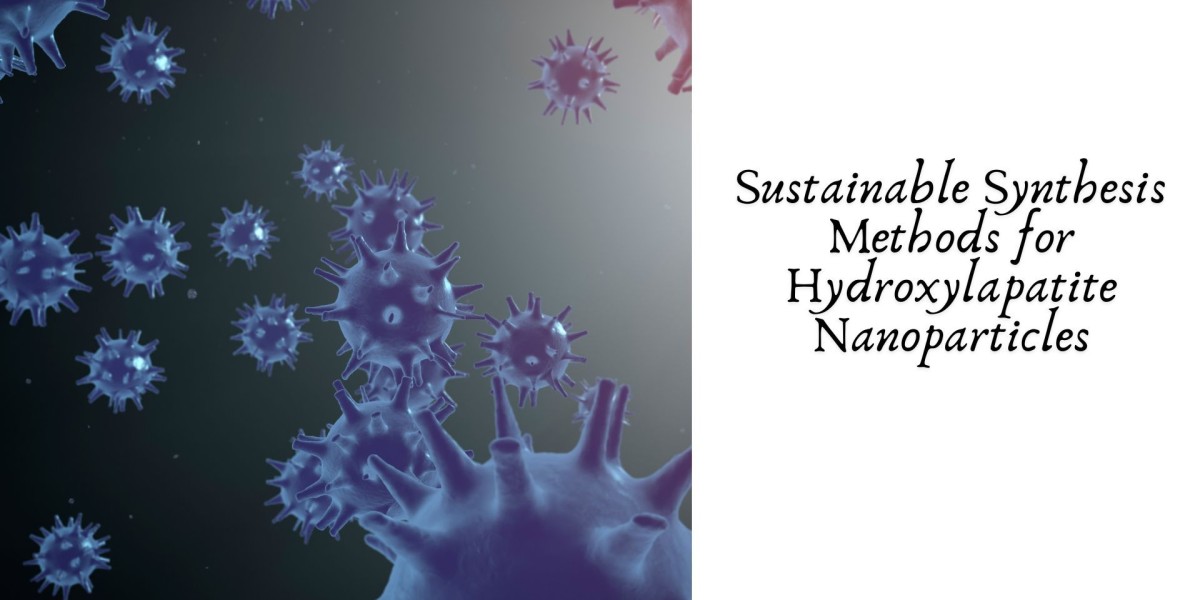Hydroxylapatite (HA), a naturally occurring mineral form of calcium apatite, has garnered significant interest in recent years, particularly due to its exceptional biocompatibility and similarity to the mineral component of bone. This has led to widespread applications of HA nanoparticles in fields such as biomedicine, orthopedics, and dentistry. However, as the demand for hydroxylapatite continues to grow, there is an increasing need to adopt sustainable synthesis methods that minimize environmental impact. This article explores various green synthesis approaches to hydroxylapatite nanoparticles, shedding light on innovative strategies to make the production process more eco-friendly and cost-effective.
Importance of Sustainable Synthesis Methods
The conventional synthesis of hydroxylapatite often involves the use of harsh chemicals, high temperatures, and significant energy consumption. These traditional processes not only contribute to increased production costs but also pose environmental hazards due to the toxic byproducts and energy waste. Therefore, developing sustainable methods that reduce environmental footprints while maintaining the quality and effectiveness of the nanoparticles is of paramount importance.
Sustainable synthesis of HA nanoparticles focuses on several aspects, such as reducing energy consumption, eliminating toxic reagents, using biodegradable and renewable raw materials, and optimizing conditions to minimize waste. By integrating these considerations, researchers are striving to make hydroxylapatite production not only more environmentally friendly but also safer for medical applications.
Green Synthesis Approaches for Hydroxylapatite Nanoparticles
Biomimetic Synthesis
Biomimetic synthesis mimics the natural processes that occur in living organisms to produce hydroxylapatite nanoparticles. This method is particularly attractive for its use of aqueous solutions and ambient temperature conditions, which significantly reduce energy consumption. Biomimetic synthesis often uses organic matrices, such as collagen, to create a scaffold on which hydroxylapatite can nucleate and grow. The process is carried out under mild conditions, which not only makes it sustainable but also results in nanoparticles that are highly biocompatible and suitable for medical applications, such as bone regeneration.
Plant Extract-Assisted Synthesis
Plant extract-assisted synthesis is gaining popularity as a green alternative for the production of hydroxylapatite nanoparticles. This method utilizes natural plant extracts as reducing and stabilizing agents in the synthesis process. Plant extracts are rich in phytochemicals like polyphenols, alkaloids, and flavonoids, which can effectively mediate the formation of nanoparticles without the need for harmful chemicals. Commonly used plants include Aloe vera, green tea, and Moringa oleifera, which not only contribute to a greener synthesis process but also add bioactive properties to the HA nanoparticles, enhancing their medical applications.
Hydrothermal Synthesis
Hydrothermal synthesis is a promising approach that involves the use of water at high temperatures and pressures to synthesize hydroxylapatite nanoparticles. This method is environmentally friendly as it uses water as a solvent, eliminating the need for organic solvents and toxic chemicals. Moreover, the hydrothermal process is energy-efficient since it allows for precise control over temperature and pressure, resulting in high-quality nanoparticles with desirable properties like uniform size distribution and crystallinity. The closed system of hydrothermal synthesis also reduces the risk of toxic emissions, making it a sustainable choice for large-scale production.
Sol-Gel Synthesis
Sol-gel synthesis is another green approach that involves the transition of a solution into a gel to produce hydroxylapatite nanoparticles. This method is advantageous because it operates at relatively low temperatures and uses water or ethanol as solvents, which are less harmful compared to other chemicals used in conventional methods. The sol-gel process allows for precise control over the chemical composition and size of the nanoparticles, which is crucial for applications in biomedical fields. Additionally, the simplicity of the sol-gel method makes it an attractive option for scaling up production while maintaining sustainability.
Eggshell Waste as a Calcium Source
Using biowaste, such as eggshells, as a calcium source for the synthesis of hydroxylapatite nanoparticles is a novel approach that aligns with the principles of sustainability and circular economy. Eggshells, which are rich in calcium carbonate, can be processed to extract calcium, which is then used in the synthesis of HA nanoparticles. This method not only reduces waste by repurposing eggshells but also eliminates the need for mining calcium sources, thus conserving natural resources. The use of biowaste significantly reduces production costs while contributing to environmental conservation.
Microwave-Assisted Synthesis
Microwave-assisted synthesis has emerged as an energy-efficient method for producing hydroxylapatite nanoparticles. By using microwave irradiation, the reaction times are significantly reduced compared to conventional heating methods. The rapid heating mechanism also leads to better control over particle size and morphology. This method is considered sustainable because it consumes less energy, minimizes reaction times, and reduces the need for excess reagents, making it a greener alternative for hydroxylapatite production.
Advantages of Sustainable Hydroxylapatite Synthesis
Reduced Environmental Impact: Green synthesis methods eliminate or reduce the use of toxic chemicals and minimize energy consumption. This significantly lowers the environmental footprint associated with hydroxylapatite production.
Cost-Effectiveness: Sustainable methods often utilize natural and renewable raw materials, such as plant extracts or biowaste, which are inexpensive compared to the chemicals used in conventional processes. This helps in reducing the overall cost of production, making HA nanoparticles more accessible for medical applications.
Biocompatibility: Methods like biomimetic synthesis and plant-assisted synthesis result in nanoparticles that are more biocompatible. This is especially important for biomedical applications, where the compatibility of materials with human tissue is crucial.
Scalability: Many green synthesis methods, such as hydrothermal and sol-gel processes, are scalable, making them suitable for large-scale production without compromising sustainability. The ability to produce hydroxylapatite nanoparticles on a commercial scale using green methods is key to meeting the growing demand while maintaining environmental responsibility.
Challenges and Future Directions
Despite the progress made in the sustainable synthesis of hydroxylapatite nanoparticles, several challenges remain. One of the major challenges is achieving the desired purity and crystallinity of HA nanoparticles while using green methods. Additionally, scaling up some of these processes to meet industrial demand without compromising quality remains a complex issue.
Future research should focus on optimizing the existing green synthesis methods to enhance the quality of the produced nanoparticles. Combining different sustainable approaches, such as integrating plant extract-assisted and hydrothermal methods, may yield more efficient and eco-friendly results. Advances in nanotechnology, such as the development of novel catalysts that reduce reaction times and energy requirements, could also play a significant role in making hydroxylapatite synthesis more sustainable.
Another promising direction is the use of machine learning and artificial intelligence to predict optimal synthesis conditions, reducing trial and error, and ultimately minimizing resource consumption. Such technological integration could revolutionize the field, making sustainable production more efficient and scalable.
Conclusion
The demand for hydroxylapatite nanoparticles in various industries, especially in the biomedical field, necessitates the adoption of sustainable synthesis methods. Green synthesis approaches, such as biomimetic synthesis, plant extract-assisted synthesis, hydrothermal methods, sol-gel synthesis, and the use of biowaste like eggshells, are proving to be promising alternatives to traditional methods. These sustainable approaches not only minimize environmental impact but also offer cost-effective and biocompatible solutions, making them ideal for large-scale production.
While challenges remain in optimizing these processes, ongoing research and technological advancements are paving the way for a greener future in hydroxylapatite nanoparticle production. By embracing these sustainable methods, industries can meet the growing demand for hydroxylapatite while contributing to environmental conservation and ensuring the safety and quality of the nanoparticles produced.







